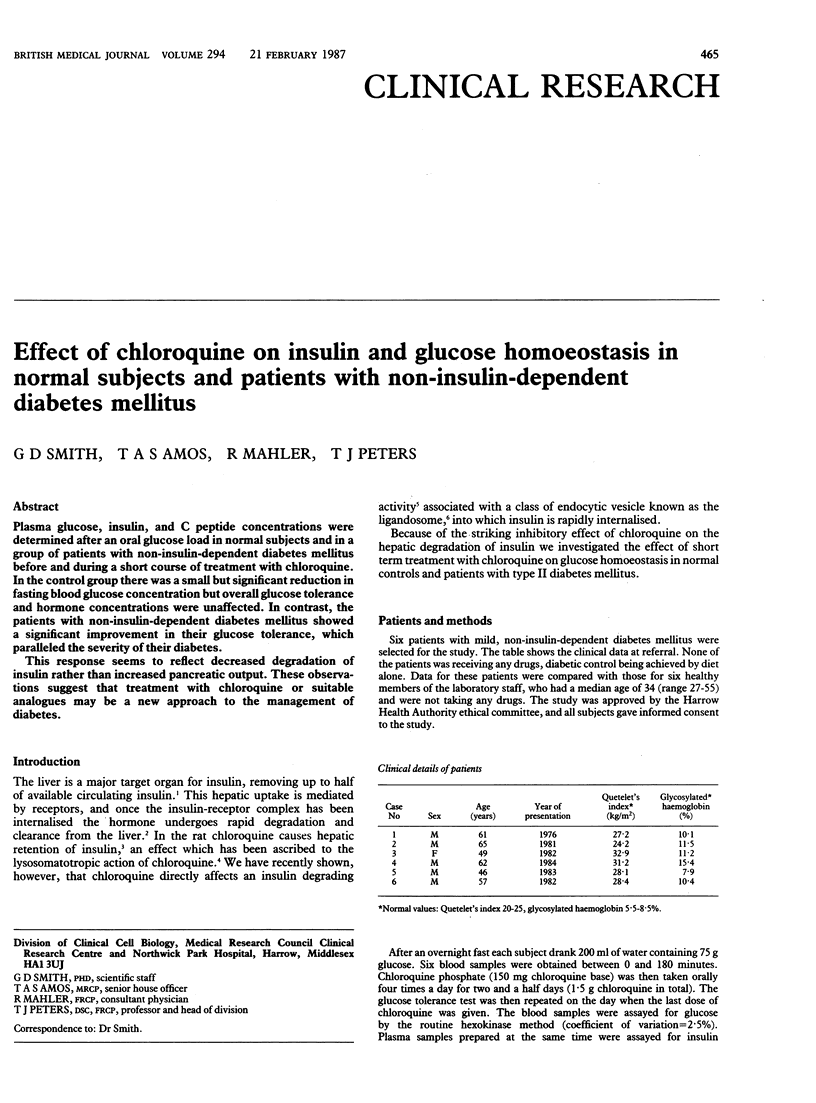Abstract
Plasma glucose, insulin, and C peptide concentrations were determined after an oral glucose load in normal subjects and in a group of patients with non-insulin-dependent diabetes mellitus before and during a short course of treatment with chloroquine. In the control group there was a small but significant reduction in fasting blood glucose concentration but overall glucose tolerance and hormone concentrations were unaffected. In contrast, the patients with non-insulin-dependent diabetes mellitus showed a significant improvement in their glucose tolerance, which paralleled the severity of their diabetes. This response seems to reflect decreased degradation of insulin rather than increased pancreatic output. These observations suggest that treatment with chloroquine or suitable analogues may be a new approach to the management of diabetes.
Full text
PDF


Selected References
These references are in PubMed. This may not be the complete list of references from this article.
- Blazar B. R., Whitley C. B., Kitabchi A. E., Tsai M. Y., Santiago J., White N., Stentz F. B., Brown D. M. In vivo chloroquine-induced inhibition of insulin degradation in a diabetic patient with severe insulin resistance. Diabetes. 1984 Dec;33(12):1133–1137. doi: 10.2337/diab.33.12.1133. [DOI] [PubMed] [Google Scholar]
- Caro J. F., Muller G., Glennon J. A. Insulin processing by the liver. J Biol Chem. 1982 Jul 25;257(14):8459–8466. [PubMed] [Google Scholar]
- Dennis P. A., Aronson N. N., Jr The effects of low temperature and chloroquine on 125I-insulin degradation by the perfused rat liver. Arch Biochem Biophys. 1981 Nov;212(1):170–176. doi: 10.1016/0003-9861(81)90356-8. [DOI] [PubMed] [Google Scholar]
- Field J. B. Extraction of insulin by liver. Annu Rev Med. 1973;24:309–314. doi: 10.1146/annurev.me.24.020173.001521. [DOI] [PubMed] [Google Scholar]
- Kahn C. R. Insulin resistance: a common feature of diabetes mellitus. N Engl J Med. 1986 Jul 24;315(4):252–254. doi: 10.1056/NEJM198607243150410. [DOI] [PubMed] [Google Scholar]
- Pease R. J., Smith G. D., Peters T. J. Degradation of endocytosed insulin in rat liver is mediated by low-density vesicles. Biochem J. 1985 May 15;228(1):137–146. doi: 10.1042/bj2280137. [DOI] [PMC free article] [PubMed] [Google Scholar]
- Phillips R. E., Looareesuwan S., White N. J., Chanthavanich P., Karbwang J., Supanaranond W., Turner R. C., Warrell D. A. Hypoglycaemia and antimalarial drugs: quinidine and release of insulin. Br Med J (Clin Res Ed) 1986 May 17;292(6531):1319–1321. doi: 10.1136/bmj.292.6531.1319. [DOI] [PMC free article] [PubMed] [Google Scholar]
- Smith G. D., Peters T. J. The localization in rat liver of alkaline phosphodiesterase to a discrete organelle implicated in ligand internalization. Biochim Biophys Acta. 1982 May 5;716(1):24–30. doi: 10.1016/0304-4165(82)90198-2. [DOI] [PubMed] [Google Scholar]
- Terris S., Hofmann C., Steiner D. F. Mode of uptake and degradation of 125I-labelled insulin by isolated hepatocytes and H4 hepatoma cells. Can J Biochem. 1979 Jun;57(6):459–468. doi: 10.1139/o79-059. [DOI] [PubMed] [Google Scholar]


